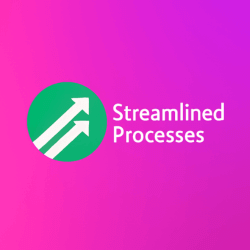For Task Streamlining Techniques, see our main page here.
Why Task Streamlining Matters in Today’s Fast-Paced World
In the modern workplace, time leaks are costly. Task Streamlining Techniques help plug those leaks by eliminating waste, reducing complexity, and accelerating results. They’re not about rushing—they’re about doing smart work, not just hard work.
Consider a marketing agency handling client reports manually. By automating templates and using scheduling tools, they saved 12 hours weekly. That’s a classic example of streamlining in action. So, while speed is part of it, clarity and consistency matter more.
Common Pitfalls That Delay Progress
Before diving into techniques, it’s smart to understand where most teams go wrong. Delay often stems from unclear objectives, duplicated efforts, poor tools, or inefficient meetings. These delays can lead to confusion, reduced morale, and missed deadlines.
For example, if two departments unknowingly work on the same project, it wastes time and resources. This is why centralizing work and standardizing project naming conventions can make a huge difference. Task Streamlining Techniques address this by creating better workflows.
Core Principles Behind Effective Task Streamlining Techniques
Streamlining isn’t one-size-fits-all. However, certain principles consistently elevate performance across industries:
- Simplicity: Reduce tasks to their clearest form. Eliminate fluff.
- Automation: If a task repeats, automate it. This frees human focus.
- Standardization: Minimize variation by creating process templates.
- Prioritization: Tackle high-impact work first and avoid multitasking.
- Visibility: Use dashboards or shared tools so progress is always clear.
These principles help teams work smarter. When applied consistently, they reshape how organizations think about productivity.
Choosing the Right Digital Tools for Task Streamlining Techniques
Not all tools are created equal. Picking the wrong software can complicate things. On the other hand, the right tool amplifies speed and quality. Consider the following categories when choosing support for your task streamlining efforts:
- Task Management Platforms: Tools like Asana, Trello, or ClickUp offer clear timelines and assignments.
- Automation Software: Zapier and Make allow integration between apps to trigger actions automatically.
- Time Tracking Apps: Tools such as Toggl or RescueTime improve awareness and identify time wasters.
- Collaboration Suites: Google Workspace and Microsoft 365 enable real-time communication and updates.
For example, a software team using GitHub integrated with Slack receives instant deployment status updates. Consequently, fewer meetings are needed. That’s a simple but effective case of using technology to streamline operations.
Using Task Streamlining Techniques to Improve Team Collaboration
Task Streamlining Techniques do more than just save time—they foster better teamwork. When everyone understands the process and expectations are aligned, collaboration improves naturally. In addition, task visibility ensures that no one is overwhelmed or left behind.
Establish rituals that support streamlined collaboration, such as:
- Start-of-week planning meetings with clear objectives
- End-of-week reviews to discuss blockers and achievements
- Shared Kanban boards displaying current tasks and owners
- Defined handoff protocols between departments or shifts
When project steps are visible and roles are known, wasted check-ins and email threads drop dramatically.
Real-World Examples of Task Streamlining Techniques in Action
Across industries, from education to healthcare, task streamlining has produced noticeable success. For instance, a hospital reduced nursing paperwork by using tablet-based forms and auto-filled patient history fields. As a result, nurses had more time for care and less friction from admin overload.
In another case, an e-commerce company streamlined its product listing workflow. Previously, five people edited content separately. After applying templated fields and automation, the team reduced listing time by 60%.
These stories show that task streamlining isn’t theory—it’s practical and measurable when implemented mindfully.
When to Re-Evaluate Your Workflows
Even streamlined systems can get stale. Therefore, it’s important to audit processes regularly. Ask these guiding questions:
- Are team members frequently confused or duplicating work?
- Are there manual steps that could be automated?
- Is your current toolset fully utilized or outdated?
- Has business size or focus changed recently?
Conducting bi-annual workflow reviews helps catch inefficiencies early. Moreover, it reveals areas where Task Streamlining Techniques may need updating or retooling.
How AI Is Integrated into Task Streamlining Techniques
AI has introduced new layers of efficiency. Tools now suggest next steps, flag delayed tasks, or generate reports with zero input. For example, customer support bots filter tickets before a human ever steps in. This reduces load and sharpens response time.
Likewise, predictive task prioritization uses historical data to reorder tasks dynamically. Above all, AI reduces guesswork. However, it must be guided by human logic and values to avoid robotic errors or oversights.
This article was created with the assistance of AI tools and reviewed by our team at Streamlined Processes LLC to ensure accuracy and relevance.
FAQ: Addressing Common Questions About Task Streamlining Techniques
Is streamlining the same as automating?
No. Automation is a component of streamlining. Streamlining covers the whole process—from deciding which steps matter to how they’re executed, automated or not.
What’s the best starting point for small teams?
Start with task tracking and daily standups. This shows where time goes and reveals bottlenecks quickly. Then, begin standardizing repeatable actions.
Can Task Streamlining Techniques apply to creative work?
Absolutely. While creativity varies, the workflow around creative output can still follow patterns. Design teams often use templates, review cycles, and automation for approvals to streamline their tasks.
How often should workflows be reviewed?
Ideally, every 6 to 12 months. This ensures tweaks align with company growth, tool changes, or client expectations.
Final Thoughts on Building Sustainable Efficiency
Implementing Task Streamlining Techniques takes effort, but the payoff is real and long-lasting. Whether you’re a solopreneur or team leader, small gains compound quickly. Furthermore, streamlined systems reduce overwhelm and burnout while boosting productivity and clarity.
Success isn’t about removing every task—it’s about refining what matters and creating room for deep focus. That mindset shift, supported by the right tools and techniques, brings real efficiency within reach.
Follow us on Facebook here.

